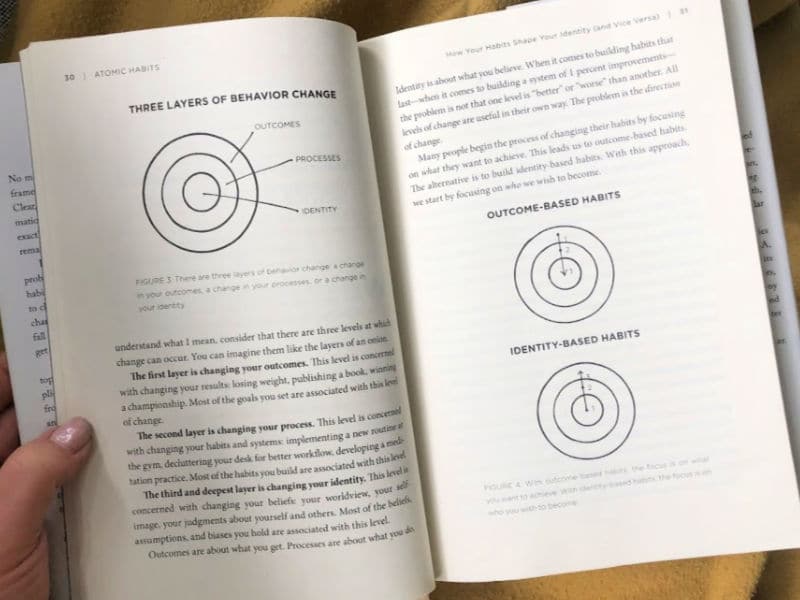I’m sitting here, writing this post on my couch in my yoga pants. But for the first time in years, I’m wearing them for the actual purpose for which they’re made: yoga. As soon as I hit publish, I’m doing my workout. And then they’ll go back in my workout bag, when I’ll get them out tomorrow to do my workout routine again. Five days a week, sometimes six.
Who am I even?
For the longest time, I’ve thought of myself as a health-conscious adult but have had the hardest time sticking to exercise. I could easily spout out a bullet point list of benefits for moving your body, but I personally would find it excruciatingly difficult to actually move my body myself.
In fact, there was a season when I had a membership at the Y, and I’d get dressed in workout clothes, send my (then) little kids to childcare, and use that time to get some work done. I’d write, computer and latte on the table, in my sweat-free workout clothes.
I knew there was some key ingredient missing in all this, because I intrinsically cared. I really did. I’ve eaten well habitually for a long time — whole foods, paleo-ish, no sodas, and the like. I drink water all day long. That part of the equation is instinct to me.

I even knew from personal experience how much better I’d feel when I would work out, even in small doses. So, I knew upstairs the benefits to movement.
But I still wouldn’t prioritize it. Days of “I’ll do it tomorrow” turned into weeks, then months. Then seasons would whoosh by when I promised it’d be the year I’d focus on my health, and before I knew it, an entire year would be in the books, when I worked out maybe once a month on average for the entire 12 months.
Cut to today, late March 2019: I’ve worked out almost every day this year. And I have no desire to ever stop. What’s different?
Here’s my theory. Actually, I’m pretty sure there are three mindset shifts that have been key for me.
1. I shifted from outward to inward.
I’ve already mentioned how much I love Atomic Habits, by James Clear. I listened to the audiobook over Christmas break, and I loved it so much I bought the hard copy so I could take notes and re-read (which I did the first week of January). If I could point to one foundational manifesto on habits that guided me to my current mindset shift, it’s this book. I plan to make it an annual read.

Early in the book, Clear talks about something simple and obvious, but it had never occurred how it applied to me personally before. He points out that if we’re focused on either outcomes or processes, we’re focusing on the wrong thing. Instead, to make a habit truly intrinsic (meaning, deep-rooted, from within), we should focus on our identity.
For example, if someone wants to lose weight, they might naturally want to focus on the outcome (to be thin) or the process (stick to a diet). But those won’t last, long-term, because the goal becomes an outcome-based habit. Behavior incongruent with your inner self won’t last.
Instead, the person should focus on their identity, that inner self: I want to be a person who is healthy. I want to be someone at their ideal weight. I want to be someone who daily makes healthy choices.
It’s the difference between when offered a cigarette, someone who says, “No thanks, I’m trying to quit” vs. “No thanks, I’m not a smoker.”
This mindset shift has been everything for me, because up to this year, my focus has (unintentionally) been either an outcome or a process. The problem for me: whenever I no longer cared about either of those (even for one minute), I wouldn’t care about cultivating the habit necessary to get there. So I wouldn’t do it.
Turning this around into an identity-based habit has been key, because as I mentioned, I’ve always thought of myself as a health-oriented person. I care about what I feed my body, what I put on my body, and getting enough sleep. By those earmarks, I was a healthy person.
But my lack of movement throughout the day said otherwise. Take those things away, and I was near-sedentary, sitting with my laptop for huge chunks of the day. Even at a standing desk (which I’d use and then lose interest in), I still wouldn’t move. I wouldn’t do things to get stronger, which has ultimately been my desired outcome.
I want to be someone who exercises. I want to be a person who moves her body all throughout the day. I want to be someone whose lifestyle matches her philosophy. I want to be a physically strong woman. I want to be a mother who models for her kids what it means to be active in our ever-increasingly sedentary world.
I want these identities. I want my outsides to match my insides.
As soon as I realized I was tracking the wrong goal, I changed my focus to an identity-based habit, using a growth mindset (vs. fixed) to prove to myself, with small wins, that I am the type of person I already want to be.
2. I started ridiculously small.
This is key — it’s those small wins that have kept me working out almost daily since January 1 this year. Because I’m no longer focusing on a big outcome-based goal (“be in shape”), I have full permission to start small.
Clear suggests starting your habits ridiculously small, laughably small — as in, instead of running a mile when you’ve never made it around the block, your first goal should be to put on your running shoes. Seriously.

Now, I say I was sedentary — I wasn’t in the truest sense. I did go on daily walks, usually twice a day, so I did move. I just didn’t push myself into an active state of movement. So, my first baseline target was 15 minutes of movement, three times a week. I gave myself freedom to make said movement easy. And it worked.
At first, I eased into basic beginner’s Pilates (I used to do ballet, and Pilates scratches that itch still in me). I did this with no specific outcome-oriented goal; I simply focused on noticed how it felt. And it felt great. It became easy.
So I increased the amount, moving to 15 minutes, five times a week. This whole time, I kept it reachable, small, easy — the very opposite I assumed my goals needed to be if I were going to reach them. (Heck, I teach goal-setting in my class, and my mind was exploding with this approach.)
I then shifted to a different type of movement, one that I felt had more capacity to make me stronger. And it officially kicks my butt, in a good way. It’s not so hard as to be unreachable; in fact, one of the premises is to half-ass it if you need to.
Starting small has given me permission to do it my way. I’m not trying to impress anyone, I’m not in this to do anything beyond getting stronger, so that my outside lifestyle matches my inward values. And because it’s small, it’s doable.
3. I keep it fun.
Because it’s small, and because my focus is on being on a person that prioritizes my health in both words and actions, working out has become a thing I enjoy instead of a torture device I try to endure “because I’m a grownup.”
For me, movement needs to be something I enjoy doing. It needs to be a form of self-care, not a thing to whip myself as a form of punishment for being sedentary. And when I define self-care as “doing the things that help me be most like myself,” well then, I’ve got myself a win-win-win situation.

Working out almost feels like a game to me now. A hard game that pushes me, yes, but one that makes me the person I know I am inwardly — it makes me a better person. I enjoy marking my progress as I get better. I focus on the progress, the act of the habit itself, not a goal.
These three mindset shifts: making movement an identity-based habit, making it doable, and making it fun, has made all the difference for me. And I look forward to seeing where this takes me.
A few helpful resources:
- Atomic Habits, by James Clear — if you read any nonfiction this year, make it this one
- James’ blog, where he writes quite a bit about habits
- If you’re curious, the workout method I currently use is Momma Strong + yoga on YouTube (Yoga with Kassandra and Yoga with Adrienne)
Learning anything else new lately about habit formation?



